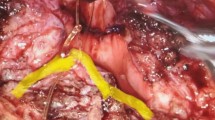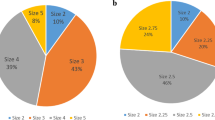Abstract
Objectives
To evaluate the role of bladder training during postoperative hospital stay in patients submitted to nerve-sparing radical hysterectomy, and to identify any clinical or surgical factor associated with postoperative bladder dysfunction.
Design, setting, and participants
Parallel group randomized single institution trial, on gynaecologic malignancies patients conducted in Catholic University of Sacred Heart Rome, between April 2009 and November 2011. Randomization was on 1:1, using a block randomized computer-generated list.
Interventions
Patients underwent Querleu-Morrow type B2 or C1 radical hysterectomy. After 2 days from surgery, patients were randomized to perform or not bladder training (scheduled clamping and unclamping of the trans-urethral catheter every three hours). Main outcome measures Necessity and duration of clean intermittent self catheterization.
Results
Randomized participants were 111 women (bladder training arm n = 55; control arm n = 56). A total of 22 women (19.8 %) required clean intermittent self catheterization, equally distributed in the two arms. At univariate analysis, only the type of radical hysterectomy was significantly associated with need of clean intermittent self catheterization (type C1 vs. type B2; p = 0.013). At univariate analysis, duration of clean intermittent self-catheterization was not associated with age, BMI, type of hysterectomy and of neo-adjuvant treatment.
Conclusions
Functional bladder disfunctions are the most common long-term complications following radical hysterectomy. Systematic postoperative bladder training following nerve-sparing radical hysterectomy does not influence the rate of urinary retention or re-admission for bladder catheterization.
Similar content being viewed by others
References
Golse N, Bakrin N, Passot G et al (2012) Iterative procedures combining cytoreductive surgery with hyperthermic intraperitoneal chemotherapy for peritoneal recurrence: postoperative and long-term results. J Surg Oncol 106:197–203
Wright JD, Lewin SN, Deutsch I, Burke WM, Sun X, Herzog TJ (2011) The influence of surgical volume on morbidity and mortality of radical hysterectomy for cervical cancer. Am J Obstet Gynecol 205:225
Landoni F, Maneo A, Cormio G, Perego P, Milani R, Caruso O, Mangioni C (2001) Class II versus 240 class III radical hysterectomy in stage IB-IIA cervical cancer: a prospective randomized study. Gynecol Oncol 80:3–12
Charoenkwan K (2010) A simplified technique for nerve-sparing type III radical hysterectomy: by reorganizing their surgical sequence, surgeons could more easily identify key nerves. Am J Obstet Gynecol 203:600
Ercoli A, Delmas V, Gadonneix P et al (2003) Classical and nerve-sparing radical hysterectomy: an evaluation of the risk of injury to the autonomous pelvic nerves. Surg Radiol Anat 25:200–206
Ceccaroni M, Roviglione G, Spagnolo E et al (2012) Pelvic dysfunctions and quality of life after nerve-sparing radical hysterectomy: a multicenter comparative study. Anticancer Res 32:581–588
Querleu D, Morrow CP (2008) Classification of radical hysterectomy. Lancet Oncol 9:297–303
Vizza E, Pellegrino A, Milani R et al (2011) Total laparoscopic radical hysterectomy and pelvic lymphadenectomy in locally advanced stage IB2-IIB cervical cancer patients after neoadjuvant chemotherapy. Eur J Surg Oncol 37:364–369
Vitobello D, Siesto G, Pirovano C, Ieda N (2013) Surgical outcomes of robotic radical hysterectomy after neoadjuvant chemotherapy for locally advanced cervical cancer: comparison with early stage disease. Eur J Surg Oncol 39:87–93
Rydzewska L, Tierney J, Vale CL et al (2010) Neoadjuvant chemotherapy plus surgery versus surgery for cervical cancer. Cochrane Database Syst Rev 1:CD007406
Colombo N, Peiretti M (2012) Critical review of neoadjuvant chemotherapy followed by surgery for locally advanced cervical cancer. Int J Gynecol Cancer 20(11 Suppl 2):S47–S48
Raspagliesi F, Ditto A, Fontanelli R et al (2006) Type II versus type III nerve-sparing radical hysterectomy: comparison of lower urinary tract dysfunctions. Gynecol Oncol 102:256–262
Williamson ML (1982) Reducing post-catheterization bladder by dysfunction reconditioning. Nurs Res 31:28–30
Bergman A, Matthews L, Ballard CA (1987) Bladder training after surgery for stress urinary incontinence: is it necessary? Obstet Gynecol 70:909–912
Fernandez RS, Griffiths RD (2005) Clamping short-term indwelling catheters: a systematic review of the evidence. J Wound Ostomy Continence Nurs. 32:329–336
Jackson KS, Naik R (2006) Pelvic floor dysfunction and radical hysterectomy. Int J Gynecol Cancer 16:354–363
Rob L, Halaska M, Robova H (2010) Nerve-sparing and individually tailored surgery for cervical cancer. Lancet Oncol 11:292–301
Naik R, Jackson KS, Lopes A, Cross P, Henry JA (2010) Laparoscopic assisted radical vaginal hysterectomy versus radical abdominal hysterectomy—a randomised phase II trial: perioperative outcomes and surgicopathological measurements. BJOG 117:746–751
Magrina JF, Pawlina W, Kho RM, Magtibay PM (2011) Robotic nervesparing radical hysterectomy: feasibility and technique. Gynecol Oncol 121:605–609
Estape R, Lambrou N, Diaz R, Estape E, Dunkin N, Rivera A (2009) A case matched analysis of robotic radical hysterectomy with lymphadenectomy compared with laparoscopy and laparotomy. Gynecol Oncol 113:357–361
Zullo MA, Manci N, Angioli R, Muzii L, Panici PB (2003) Vesical dysfunctions after radical hysterectomy for cervical cancer: a critical review. Crit Rev Oncol Hematol 48:287–293
Naik R, Nwabinelli J, Mayne C, Nordin A, de Barros Lopes A, Monaghan JM, Hilton P (2001) Prevalence and management of (non-fistulous) urinary incontinence in women following radical hysterectomy for early stage cervical cancer. Eur J Gynaecol Oncol 22:26–30
Xu H, Chen Y, Li Y, Zhang Q, Wang D, Liang Z (2007) Complications of laparoscopic radical hysterectomy and lymphadenectomy for invasive cervical cancer: experience based on procedures. Surg Endosc 21:960–964
Fagotti A, Fanfani F, Longo R, Legge F, Mari A, Gagliardi ML, Scambia G (2007) Which role for pre-treatment laparoscopic staging? Gynecol Oncol 107:101–105
Cibula D, Sláma J, Velechovská P, Fischerova D, Zikán M, Pinkavová I, Hill M (2010) Factors affecting spontaneous voiding recovery after radical hysterectomy. Int J Gynecol Cancer 20:685–690
Ralph G, Winter R, Michelitsch L, Tamussino K (1991) Radicality of parametrial resection and dysfunction of the lower urinary tract after radical hysterectomy. Eur J Gynaecol Oncol 12:27–30
Fotiou S, Tserkezoglou A, Hatzieleftheriou G, Apostolikas N (1997) Class III vs. class II radical hysterectomy in stage IB cervical carcinoma: a comparison of morbidity and survival. Int J Gynecol Cancer 7:117–121
Turnbull H, Burbos N, Abu-Freij M, Duncan TJ, Nieto JJ (2012) A novel approach to postoperative bladder care in women after radical hysterectomy. Arch Gynecol Obstet 286:1007–1010
Wells TH, Steed H, Capstick V, Schepanksy A, Hiltz M, Faught W (2008) Suprapubic or urethral catheter: what is the optimal method of bladder drainage after radical hysterectomy? J Obstet Gynaecol Can 30:1034–1038
Chamberlain DH, Hopkins MP, Roberts JA, McGuire EJ, Morley GW, Wang CC (1991) The effects of early removal of indwelling urinary catheter after radical hysterectomy. Gynecol Oncol 43:98–102
Conflict of interest
The authors declare no conflict of interest.
Author information
Authors and Affiliations
Corresponding author
Rights and permissions
About this article
Cite this article
Fanfani, F., Costantini, B., Mascilini, F. et al. Early postoperative bladder training in patients submitted to radical hysterectomy: is it still necessary? A randomized trial. Arch Gynecol Obstet 291, 883–888 (2015). https://doi.org/10.1007/s00404-014-3500-5
Received:
Accepted:
Published:
Issue Date:
DOI: https://doi.org/10.1007/s00404-014-3500-5




